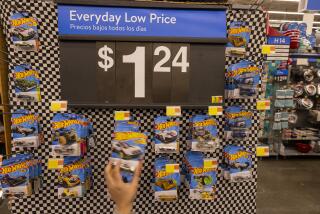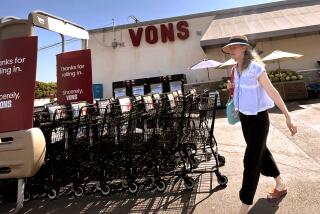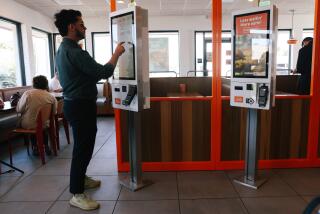SHELF SHUFFLE : Grocery chains are using bar code data to determine food placement from soup to nuts.
- Share via
Nothing was where it was supposed to be at the Vons supermarket in La Crescenta.
Where customers could have picked up pickles a day before, suddenly they were peering at Pepperidge Farm cookies instead. And where they once sought salad dressing, they saw soup--and vice versa.
Although you couldn’t prove it by these mixed-up shoppers, the upheaval was part of Vons’ effort to make shopping less frustrating for them and, not incidentally, more profitable for the company.
By undertaking a massive overnight transformation of the store--one of about 160 former Safeway locations--the grocery hoped to provide a more logical store layout, with better placement and added space for fast-selling products.
Granted, some of it seemed like sheer common sense--putting cookies instead of pickles next to the ice cream cases, for example.
Fast Response to Changing Tastes
But for figuring out which items to stock--and where to put them--Vons relied mostly on a new computer-based marketing strategy that is sweeping the food industry: shelf space management.
Thanks to shelf-management software programs with names such as Accuspace, Apollo and Spaceman, many of the nation’s big food chains are starting to put to better use the flood of sales information that they gather from checkstand bar code scanners.
Using the data, they are able to respond to changing tastes by quickly reallocating shelf space to provide more room for fast-selling items and to boot out any duds. Revampings such as the one at Vons may be rare, but customers undoubtedly are noticing subtle changes in the way many stores are laid out.
“For the first time, this provides a method for truly tailoring” stores to customers’ needs, said Willard Bishop, a Chicago-based retail consultant.
Chains say the technology lets them get away from the cookie-cutter approach of the past that meant all stores carried basically the same products in the same configuration, without regard for the ethnic makeup or income level of the neighborhood.
But critics argue that using sales data to determine shelf placement puts small food companies with new products at a severe disadvantage by perpetuating the power of big marketers.
“A lot of times things are bought because of the way they’re made available,” said Michael Rose, managing partner of Spacemetrics Group in Inglewood, a firm that advises retailers on store design. “Usually, when things aren’t moving well, it’s because of where they’re placed. Obviously, every manufacturer wants his product at eye level.”
That may generally be the case, but there are exceptions. According to Vons, Best Foods mayonnaise has secured its place as the top-selling brand from the bottom shelf. Ditto for Cheerios and Tide, which benefit from deeper shelves that can hold more boxes or jars.
Most observers point to the benefits of shelf-management technology.
Analyzing sales data, they say, helps to winnow out slow-moving products so that stores can give more space to perennial favorites or promising new items. That helps chains better manage inventories and cut down on the persistent problem of “out of stocks,” which irk customers and reduce sales.
After analyzing consumer “votes” for products on a store-by-store basis, retailers can devise computerized descriptions or pictures of shelf layouts, known as schematics, that detail how many packages, or “facings,” of each product appear at the front of the shelf, and where the product will be placed.
Automatic Arrangements
Good space management, retailers note, depends on precise package measurements. Certified Grocers, a large Los Angeles wholesaler, has on file the dimensions of 35,000 grocery items, all measured to “the nearest tenth of an inch,” according to Jim Swan, manager of the cooperative’s shelf allocation program.
The computer software automatically takes the measurements into account when determining shelf arrangements. Some programs generate lifelike pictures, with digitally produced representations of products. Others spew out written descriptions that stockers interpret as they put items on the shelves.
Much of this may seem elementary, but retailers acknowledge that, until the advent of bar code scanning and shelf-management programs, they often failed to spot and fix trouble on the shelves fast enough.
Take Ralphs Grocery, which solved a persistent problem by using the Spaceman program, owned by a subsidiary of A. C. Nielsen Co. The chain, based in Compton, found that some stores routinely ran out of paper products but usually had an oversupply of bleach. As a result, it added 12 feet of shelf space for paper products by stealing space from bleach and other products.
Vons uses the Accuspace program to analyze sales and assign space for stores in five “demographic clusters”: high Anglo/high income, high Anglo/low income, high Latino/low income, high to moderate Latino with no income specified, and average, which covers about half of Vons’ 342 stores.
At Vons’ Tianguis stores, where about 95% of customers are Latino, the dominant dairy product is whole milk in gallon jugs. In contrast, at the chain’s upscale Pavilions stores, customers tend to buy more low-fat or nonfat milk in half-gallon containers, so those products get more prominent display.
Vons’ mainframe computer has on line about 3,000 schematics featuring a category such as pet foods or dairy. Store managers constantly receive revised schematics that they follow in rearranging areas of the store to keep pace with changing consumer tastes.
“We try to marry different items, such as putting crackers across from soup,” said Phil Hawkins, vice president of merchandising for El Monte-based Vons. “That’s something Safeway did not do.”
5% Sales Increase
Such shifts also grease the way for more impulse purchases. Vons has seen increases in the average order size at the former Safeway stores, like the one in La Crescenta, that have been remerchandised.
Vons routinely reports sales gains of 2% to 5% that can be traced to shelf management, and those are hefty increases for the slim profit margin food business, said Frank A. Woodard, director of electronic marketing.
Clearly, stocking store shelves is not the simple matter of a few decades ago, when merchants would arrange items alphabetically, and clerks would get them off the shelves for customers.
As self-service retailing came into vogue, many stores got away from alphabetical placement and began to stock products by category. Powerful food and consumer product companies began dictating where they wanted their items to go--usually in prime eye-level spots on choice aisles. Smaller companies without marketing clout had to settle for less ideal locations, and customers would have to stoop or reach to get to their products.
To arrange shelves, store clerks would follow rough line drawings. Or, in some cases, a manufacturer’s representative would experiment with different placements using a magnetic board and tiny magnets that were facsimiles of his products.
Such methods were haphazard at best. Carelessly measured items often didn’t fit. More than occasionally, one company’s rep would encroach on another’s turf. Reordering of products was largely a matter of guesswork.
The method “was very unscientific,” said Ken Stevens, a partner at the Los Angeles office of McKinsey & Co., a management consulting firm. “It wasn’t based on sales rates but on impressions of how products were doing.”
When food marketers started coming out with thousands of new items or variations of established brands each year, retailers could no longer keep up.
With the stiff competition, food and consumer products companies have found that shelf space management is a necessary weapon for them, too. Partly in self-defense, many food makers provide shelf configurations to retailers, based on sales data analyzed by the same shelf management software that retailers use.
Carnation, for example, recently revamped the frozen food section, which included its own ice cream products, for a St. Louis chain. The category showed a 24% sales gain, according to Dick Curd, a spokesman for Carnation, the Los Angeles-based division of Nestle. At a Boston chain, a rearranged pet snacks section had a 30% increase.
Some observers see shelf management as a subtle form of manipulation that makes it too easy for people to buy items they don’t need. But Bishop, the consultant, disputes that notion.
“Is it manipulation to have some crusty bread on display next to the wine section?” he asked. “I think that is very helpful.
“The average customer is not influenced to do things they don’t want to do. It more than likely will make it easier for them to do something they would like to do.”
More to Read
Inside the business of entertainment
The Wide Shot brings you news, analysis and insights on everything from streaming wars to production — and what it all means for the future.
You may occasionally receive promotional content from the Los Angeles Times.











